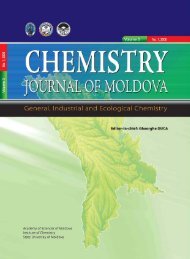2011, nr. 3 - Academia de ÅtiinÅ£e a Moldovei
2011, nr. 3 - Academia de ÅtiinÅ£e a Moldovei
2011, nr. 3 - Academia de ÅtiinÅ£e a Moldovei
Create successful ePaper yourself
Turn your PDF publications into a flip-book with our unique Google optimized e-Paper software.
240coagulopathy of chronic liver disease:a dual phase study.In: Am. J. Gastroenterol. 2003, 98(6), p. 1391-1394.7. Kaul V. V., Munoz S. Z., Coagulopathy of LiverDisease. In: Curr. Treat Options Gastroenterol., 2000, 3(6),p. 433-438.8. Gursoy S., Başcov M., Torun, Yurci A., SoyuerI., Importance of anticoagulant proteins in chronic liverdisease. In: Turk. J. Gasrtroenterol., 2005, 16(3), p. 129-133.9. Raya-Sanches J.M., Gonzales-Reimers E., Rodriguez-MartinJ.M. et al. Coagulation inhibitors in alcoholicliver cirrhosis. In: Alcohol, 1998, 15, p. 19-23.10. Bell H., O<strong>de</strong>gaard O.R., An<strong>de</strong>rsson T et al. ProteinC in patients with alcoholic cirrhosis and other liverdiseases. In: J. Hepatol., 1992, 14(2-3), p. 163-167.11. Kloczko J., Mian M., Wojtukiewicz M.Z. et al.Plasma protein C as a marker of hepatocellular damagein alcoholic liver diseases. In: Haemostasis, 1992, 22, p.340-344.12. Vigano S., Mannucci P.M., Rumi M.G. et al., Thesignifi cance of protein C antigen in acute and chronic liverbiliary disease. In: Am. J. Clin. Pathol., 1985, 84, p. 454.13. Rak K. Thrombosis promoting changes in chronicliver diseases. In: Folia Haematol, 1988, 114(3), p. 333-339.14. Mammen E.F., Coagulation abnormalities in liverdisease. In: Hematol. Oncol. Clin. North. Am., 1992,6(6), p. 1247-1257.15.RezumatÎn studiu au fost incluşi 116 pacienţi cu ciroză hepaticăîn diferit stadiu al bolii: 61 <strong>de</strong> bărbaţi şi 55 <strong>de</strong> femei cuvârsta medie <strong>de</strong> 50,3±0,7 ani. Pacienţii au fost divizaţi în3 grupuri, în funcţie <strong>de</strong> clasificarea Child-Pugh a cirozeihepatice, şi în 3 grupuri în funcţie <strong>de</strong> tratamentul aplicat.Au fost estimaţi şi comparaţi parametrii antitrombinei IIIşi proteinei C la toţi pacienţii. S-au î<strong>nr</strong>egistrat diferenţesemnificative în grupuri conform stadiului bolii şi în lotul<strong>de</strong> control, şi unele diferenţe ale parametrilor în funcţie <strong>de</strong>tratamentul aplicat.SummaryWe have studied 116 patients with liver cirrhosis indifferent stages of the disease. There were 61 men and 55women with mean age 50,3±0,7. These patients were divi<strong>de</strong>dinto 3 groups <strong>de</strong>pending on the Child-Pugh classificationand 3 groups <strong>de</strong>pending on the treatment. We haveto measured and compared antithrombin III and protein Cvalues in different groups. The parameters were comparedbetween patient groups and healthy controls. There wereregistered significant differences of antithrombin III andprotein C parameters between groups <strong>de</strong>pending on thestage of disease and some differences <strong>de</strong>pending on thetreatment.РезюмеБыло обследовано 116 больных с циррозомпечени на разных стадиях заболевания, 55 женщини 61 мужчин, средний возраст 50,3±0,7. ПациентыBuletinul AŞMбыли разделены на три группы в зависимости отклассификации цирроза по Child-Pugh и в зависимостиот лечения тоже было обследовано три группы. Мыопределили значения антитромбина III и протеина С уобследуемых больных. Были выявлены значительныестатистические различия в обследуеимых группахпо сравнению с группой контроля и обнаруженынекоторые изменения в зависимости от назначенноголечения.BOLILE CRONICE DIFUZE ALEFICATULUI ŞI HORMONII SEXUALI_______________________________________Iulianna Lupaşco, doctor în medicină,conferenţiar-cercetătorUSMF „Nicolae Testemiţanu”Ficatul participă la asigurarea şi reglarea diverselortipuri <strong>de</strong> metabolism: glucidic, lipidic, proteic,vitaminic, al mineralelor. Ficatul asigură procesele <strong>de</strong>formare şi secreţie a bilei, <strong>de</strong> <strong>de</strong>zintoxicare, participăîn reglarea proceselor <strong>de</strong> creştere şi <strong>de</strong>zvoltare a organismului,în menţinerea funcţiilor sexuale normaleşi a răspunsului imunologic a<strong>de</strong>cvat [1]. Toate acestefuncţii hepatice se realizează cu implicarea hormonilorproduşi <strong>de</strong> glan<strong>de</strong>le endocrine. Este bine cunoscutfaptul că sinteza şi secreţia majorităţii hormonilor seiniţiază prin acţiunea semnalelor stimulatoare sau inhibitoareasupra zonelor hipotalamice [1, 2].Activitatea secretorie a celulelor hormonale <strong>de</strong>pin<strong>de</strong><strong>de</strong> sensibilitatea lor individuală faţă <strong>de</strong> pepti<strong>de</strong>lehipotalamice (releasing-factori), dar şi <strong>de</strong> stareafuncţională a ficatului. Selectivitatea înaltă prin carehipofiza secretă anumiţi hormoni (foliculostimulant,luteinizant, somatotrop, tireotrop, adrenocorticotrop,prolactina) este <strong>de</strong>terminată <strong>de</strong> complexitatea semnalelorneuroumorale şi se realizează în condiţiilefuncţionării a<strong>de</strong>cvate a sistemelor enzimatice ale ficatului.Hormonii sintetizaţi <strong>de</strong> glan<strong>de</strong>le-ţintă endocrine(hormonii steroizi sexuali, tiroidieni, glucocorticoizii)participă la reglarea sintezei hormonilor tropiomonimi prin mecanisme feedback. Această legăturăpoate avea punctul <strong>de</strong> conexiune situat în hipofiză saula nivelul hipotalamusului şi poate fi <strong>de</strong>reglată în patologiahepatică [3].Hormonii sexuali feminini. Reglarea eliberăriigonadoliberinei (GL) comportă mecanisme complexe,la femei GL este responsabilă <strong>de</strong> secreţia hormonilorluteinizant (HL) şi foliculostimulant (HFS). Peparcursul unei etape a ciclului menstrual estrogeniistimulează producerea GL şi măresc sensibilitateagonadotropinelor faţă <strong>de</strong> GL. La altă etapă a ciclului
















